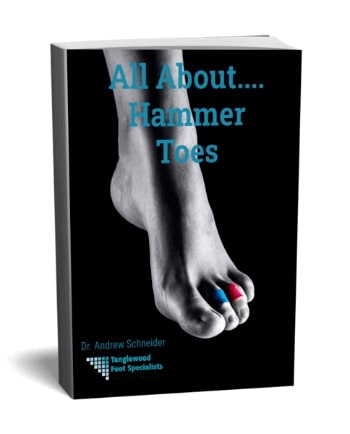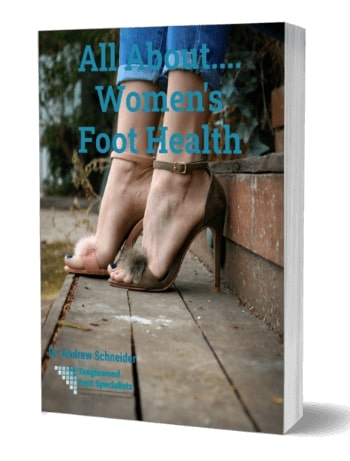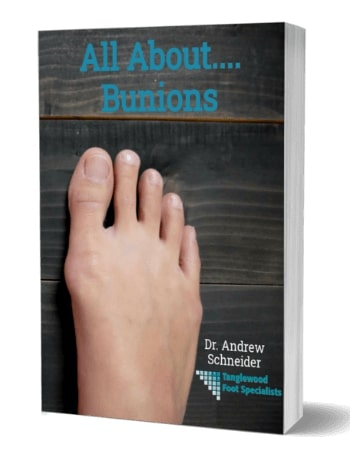
Have you noticed your toes starting to buckle? The knuckle of your toe becoming more prominent? Your toes hitting the top of the shoe? It is possible that you are developing a common deformity called a hammer toe. In fact, it is one of the most common conditions that I see in my Houston podiatry practice. The key to treating them is to get checked early. Give us a call for an immediate appointment.
What Causes Hammer Toes?
Hammer Toes are a mechanical condition. They occur as a result of a muscle imbalance in the toes. This imbalance causes the toes to deform in different ways. The condition can be flexible or rigid. A flexible hammertoe is when the toe can be straightened. A rigid hammer toe is fixed and contracted. It is so stiff that you can’t straighten the toe at all.
Hammer toes can also form because of trauma. This is especially true if you break a toe. Or even if you jam your toe. It can affect the joints and cause a deformity to form. That’s why you should get a potential broken toe checked out. Contrary to what some believe, there are things you can do for a broken toe.
Shoes are often blamed for the formation of hammer toes. If you ask me, they are blamed more often than they’re responsible for. Shoes can worsen contracted toes that are already forming. They may make them form faster as well. This is particularly true of shoes that have a tight toe box and pointy toe. High heeled shoes also add to the underlying mechanical imbalance. This imbalance worsens hammer toes.
There are Four Types of Hammer Toes:
Hammer Toes
 Hammer toes are the most common type of the deformity. There is a contracture at the first joint of the toe. This causes the toe to have a prominent knuckle that rubs against the top of the shoe. Because of this pressure, it is common for a painful corn to form.
Hammer toes are the most common type of the deformity. There is a contracture at the first joint of the toe. This causes the toe to have a prominent knuckle that rubs against the top of the shoe. Because of this pressure, it is common for a painful corn to form.
Mallet Toes
A mallet toe occurs when there is a contracture at the second joint of the toe. It causes the tip of the toe to drop down and get extra pressure. Sometimes, a corn will form over the joint. A painful corn or callus often forms at the tip of the toe.
Claw Toes
A claw toe forms when both of the middle joints of the toe become contracted. This is a very painful condition and is almost always rigid. You end up with a corn on top of both joints of the toe. You also often have a painful callus at the tip of the toe.
Adductovarus Hammer Toes
The other types of hammer toes rise up. An adductovarus hammer toe rotates so the top of your toe is facing the outside of your foot. This is most common in your 5th toes. The knuckles of the 5th toe hit the side of your shoe and causes corns to form. You might also develop a corn between your 4th and 5th toes. This one looks a bit less than a hammer than the others.
Are Hammer Toes Hereditary?
You may notice that your toes are starting to look like your mother’s or grandmother’s feet. This is because you inherit the foot mechanics from your family. While this doesn’t guarantee that you will form one yourself, it does increase your chances. Thanks Mom!
Prevention of a Hammer Toe
Hammer toes are best prevented at the earliest sign of them forming. At this point, they will still be flexible. The best preventative measures for hammer toes is to identify the cause of the deformity starting. If we can neutralize what’s causing the them to form, we can prevent them from getting worse.
Wearing the Right Shoes
Look for shoes that have plenty of room in the toes. This will help to prevent your shoes from pushing up on your toes and causing a hammer toe. You also want to be careful not to wear shoes that are too short for you. You also may want to limit the height of your high heel shoes.
Stabilize How Your Foot Functions
 Hammer toes are due to unstable mechanics. This is true if you have either a flat foot or a high-arched foot. So, making your foot mechanics more stable will slow or stop hammer toes from progressing. The easiest way to do this is with the use of a custom orthotic. An orthotic is an insole that is made especially for you. It works to make your feet work in a more efficient and stable manner. This will reduce the excessive pull and prevent deformities from occurring. It will also help to prevent a hammer toe. If you already have a minor toe contracture, a custom orthotic will stop it from worsening.
Hammer toes are due to unstable mechanics. This is true if you have either a flat foot or a high-arched foot. So, making your foot mechanics more stable will slow or stop hammer toes from progressing. The easiest way to do this is with the use of a custom orthotic. An orthotic is an insole that is made especially for you. It works to make your feet work in a more efficient and stable manner. This will reduce the excessive pull and prevent deformities from occurring. It will also help to prevent a hammer toe. If you already have a minor toe contracture, a custom orthotic will stop it from worsening.
Diagnosing Your Hammer Toe
The diagnosis of your hammer toe is straight forward. I’ll have a pretty good idea of what we’re dealing with in my clinical exam. During your physical examination able to see where the toe is contracted. I’ll also be able to tell if the toe is flexible or rigid. I’ll also take a digital x-ray in the office to look at the joints. That will give me more information on how to best treat your condition.
Treatment Options for a Hammer Toe Without Surgery
When a hammer toe is flexible, it is possible that it can be treated without surgery. Nonsurgical treatment for hammer toes include:
Custom orthotics
Custom orthotics stabilize the mechanics of the foot. While they don’t work to reverse the condition, a custom orthotic device will prevent it from becoming worse. It is a perfect treatment when you catch a hammer toe developing early.
Change to a well-fitting shoe
A comfortable shoe with a low heel and wide toe box will give plenty of room for your toes. This simple treatment will prevent them from buckling further and worsening the hammer toe.
Hammer toe splints and supports
If your hammer toe is flexible, a hammer toe splint will help to straighten the toe. There are a wide range of splints and supports available. I can recommend one that would work best for you.
Corn pads
If your hammer toe caused the formation of corns on top of your toe, a corn pad can be helpful. Padding corns reduce the pressure that caused the toe to form a corn in the first place. A word of caution: avoid medicated corn pads. They contain an acid that can burn healthy skin and make the condition worse. If you are going to use a corn pad, make sure it is non-medicated.
How Do You Know It’s Time to Consider Hammer Toe Surgery
If your hammer toe is rigid and painful, it most likely needs a surgical procedure to correct it. You also may need to consider surgery as treatment for your hammer toe if you are limited in the shoes you are able to wear without pain.
Surgical treatment to fix a hammer toe involves removing a small piece of bone from the contracted joints. In some cases, a pin is used to maintain this correction in the proper position for a few weeks and removed in the office. For rigid hammertoes, I use an implant that stays in the toe and keeps the correction. After surgery, there are stitches in the toe. The stitches say in for about 2 weeks. There is also a dressing on your foot. You keep the dressing on until I change it during your postoperative visits.
What If You Have a Hammer Toe and Bunion on the Same Foot?
 It is common to have a hammer toe on your second toe if you also have a bunion. This is because the bunion causes the big toe to move over and push up the second toe. In most of these cases, it is not recommended to surgically correct the hammer toe alone. The bunion also needs to be corrected at the same time. This will prevent the big toe from again pushing up the second toe and pushing the toe up again. Even if the bunion itself is not painful, it is necessary to perform both procedures to have a good outcome.
It is common to have a hammer toe on your second toe if you also have a bunion. This is because the bunion causes the big toe to move over and push up the second toe. In most of these cases, it is not recommended to surgically correct the hammer toe alone. The bunion also needs to be corrected at the same time. This will prevent the big toe from again pushing up the second toe and pushing the toe up again. Even if the bunion itself is not painful, it is necessary to perform both procedures to have a good outcome.
Who Should You See to Treat Your Hammer Toe?
A Houston foot doctor should be your first stop to get all your questions about your hammer toe answered. Dr. Andrew Schneider treats all toe deformities with and without surgery. He will be able to work with you to determine the best treatment plan for your unique situation. You should have healthy, pain-free feet! Call the office or request an appointment online. We will get you in right away!






















